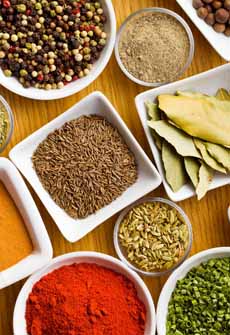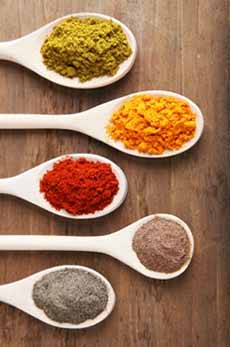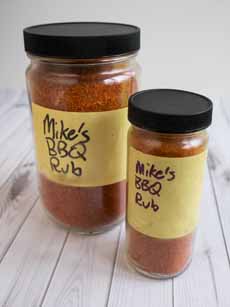|

[1] Take a look at the spices and herbs you own. Look for recipes online or use your own palate to choose what to use on your meat. These are some of the ingredients used in rubs for wild game by Wide Open Spaces.

[2] Pick what you want for your blend. Use smaller amounts of more intense spices (chiles, cumin, garlic, pepper, etc.) and larger amounts of base flavors (oregano, thyme, etc.). Use very small amounts of accent flavors like cardamom, cinnamon, lemon peel and nutmeg (photo courtesy M Magazine).

[3] When you arrive at your signature rub, bottle it and give it as gifts. This one is from Dad Cooks Dinner. |
|
Just as you can throw together a vinaigrette or a marinade in one-two-three, you can make a rub for meats and poultry.
Sure, you can buy them: But why pay big bucks for convenience foods when you can make them for pennies with ingredients you already own?
Take a quick look at your spice shelf. Allspice, chili powder and ground chiles, cinnamon, cumin, garlic powder, lemon peel, mustard powder, nutmeg, onion powder, paprika, sage and thyme all have a place in rubs (although a limit of five or so is best).
When you mix your own, you can also eliminate the large amount of salt blended into commercial rubs.
Rubs:
Seal the flavor of the meat.
Form a tasty crust on the meat.
Enhance the color of the cooked meat.
Rubs pull moisture from the air, as they draw up the juices from the inside of the meat. This process (osmosis) causes the meat to marinate itself as it cooks.
They can also be used on fish and vegetables.
There are two types of rubs:
Dry rubs are blends of herbs and spices that are rubbed onto the meat before cooking. The rubs are hand-rubbed, or sprinkled, onto on the surface of meat before it goes onto the the grill.
A dry rub is best on food that is cooked faster, at a higher temperature; and on food that probably doesn’t need to tenderize, like shrimp or chicken.
Dry rubs are also preferable on steaks and chops. Chefs generally cook them simply with salt and pepper; but if you want to add other touches of flavor, reach for a dry rub.
Some of the spices on your shelf are rubs, such as chili powder, curry powder, jerk seasoning and Old Bay; there are numerous rubs in the spices section, reflecting different cuisines (Cajun, Indian, etc.) or foods (barbecue, pork).
Rub both sides of the protein. With a whole chicken, rub the inside of the cavity as well.
The more time the rub has to react with the meat prior to cooking, the more the flavor it will yield.
Wet rubs mix the spices with oil, water or prepared mustard, to spread onto the meat. Pesto is an example of a web rub, although it’s a versatile ingredient that’s also used as a sauce.
Any dry rub you have can be turned into a wet rub. When a dry mix combines with the meat juices, it turns into a paste anyway.
Today we focus on dry rubs. If you’re grilling this weekend, it’s an opportunity to try different combinations.
Try different combinations and proportions over time. If you make too much, give it to friends or neighbors.
Aim for a signature blend for each of your favorite foods: burgers, chicken, steaks, etc. When you have that eureka! moment, you can bottle it as stocking stuffers or house gifts.
WHAT GOES INTO A RUB?
Sweet. White or brown sugar is a common ingredient because it is a flavor enhancer, it helps browning, and with crust formation. No other sweetener can substitute. If you’re concerned about adding sugar, one expert estimates that in a slab of ribs there’s one teaspoon of sugar.
Savory. Savory flavors come from amino acids called glutamates, which is why MSG has been a popular flavor enhancer. Green herbs, some spices and garlic, among others, contain glutamates.
Spices and herbs. If you’re looking for a certain flavor—curry, sesame, whatever—add it. Paprika is often included as a color enhancer.
Spicy. For some sizzle, add some heat. Common additions are black pepper, cayenne or chipotle, ginger, horseradish, and mustard powder.
Should you add salt to a rub?
|
To avoid over-salting, we recommend leaving salt out of a rub, and salting the meat as you normally would. Then apply the rub.
Note that you cannot judge how a rub will taste when it’s raw. It tastes very very different after cooking.
When the juices of the meat mix with the herbs and spices and the heat of cooking, they undergo chemical reactions. Thus, a rub may taste too hot when raw, but just right when on top of a piece of cooked meat.
Similarly, the flavors blend together. People who don’t like a particular spice may not even know that it’s there.
RUBS VS. MARINADES
You don’t use a both a rub and a marinade. Just use one for flavor. If you want to make the meat less tough, a marinade that includes vinegar is better. Otherwise, Pereg Natural Foods advises:
Rubs self-marinate the meat, so you don’t have to continue to brush with marinade as the meat cooks.
Rubs add a colorful and tasteful crust to the finished meat.
Rubs make it easier to control the final flavor of the meat.
Rubs are perfect for larger pieces of meat such as spareribs, briskets, and tenderloins.
You can apply the rub a few days before you cook the meat, wrap it up in plastic wrap or butcher paper, and place it in the fridge until you’re getting ready to cook (move it to the counter first; don’t put cold meat on the grill).
Add a generous portion of the rub at first to the meat. After it sits for a few days, add a bit more rub before cooking.
Ready, set, blend!
|





